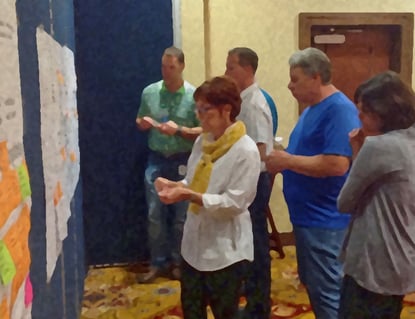When you get an email saying you have a direct message from Liz Taylor, you pay attention!
 No, not THAT Liz Taylor. THE Liz Taylor who is still doing innovative, creative work. This Liz Taylor, based in Oxford, England, ran Wow@work, helping businesses develop their creative potential. She has spent over 20 years working with clients on marketing and innovation projects in the UK, Europe and the USA. Liz is currently studying for her Masters in Organizational Psychology at Birkbeck, (University of London) and is researching creativity in organizations.
No, not THAT Liz Taylor. THE Liz Taylor who is still doing innovative, creative work. This Liz Taylor, based in Oxford, England, ran Wow@work, helping businesses develop their creative potential. She has spent over 20 years working with clients on marketing and innovation projects in the UK, Europe and the USA. Liz is currently studying for her Masters in Organizational Psychology at Birkbeck, (University of London) and is researching creativity in organizations.
Today, Liz shares her perspective on the strategy for achieving the right balance between diversity and familiarity in fostering a creative culture:
Creating a culture in which people are constantly fizzing with imagination and ideas is one of the many innovation challenges we all face. When a team becomes well-established with a track-record of success, there is always the risk that things will get too cozy. When we start to feel comfortable it’s a sign that “groupthink” and risk aversion might have started to creep in. Not good for creativity!
So, the answer is to bring in some new blood and mix things up a bit, right? New people with fresh perspectives and different thinking should fire up creativity. But, lots of new members can also create challenges. In a dynamic group it can be hard to build the good relationships and develop the shared working patterns that promote creativity. We have to continuously renegotiate and reinterpret what is going on, which increases the sense of uncertainty and reduces the psychologically safety of the group.
Psychological safety is one of the key facilitators of creativity. It encourages us to speak out and is the bedrock of “soft” communications – all those informal, spontaneous interactions that really drive ingenuity and inventiveness! Creativity needs an environment rich in openness, active listening and building behaviours. With increased diversity we should all be aware that we can fall prey to stereotyping, attribution errors, and cultural misunderstandings which can affect our communication and decision making.
So what can we do to balance benefits of diversity and “new blood” with our need for psychological safety?
- Make sure the new people feel truly welcome in the group and give everyone a chance to get to know each other (in my book, a good excuse for a few beers down at the pub but depends on your cultural leanings of course!). It’s important to appreciate each other’s views, expertise and background. This will ensure we stay open to new ideas and helps practical organization since people are familiar with each other’s capabilities.
- Be aware of and use active listening and building behaviors. No "buts" anyone!
- Ask what you can do to reduce any status differentials between functions and hierarchies. No parking privileges for senior people, and if you are the boss, make sure you get the coffee sometimes!
- Create space to experiment and improvise together to get used to working styles and expertise. HAVE FUN! Allow mistakes to happen and evaluate them without blame.
- If it’s going to be a virtual working environment for much of the time, it’s vital to create opportunities to meet up in the real world. Without face-to-face contact you will compromise the creative potential of your group. People create ideas, not processes!
- If you are an old-timer (like me!) check you are staying fresh and keep challenging yourself, mix with new people, take a sabbatical or work on a voluntary project to try something new! - Liz Taylor




